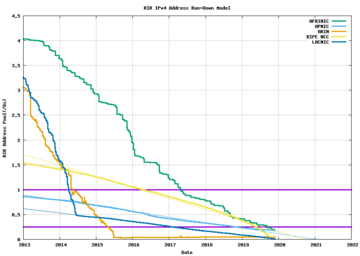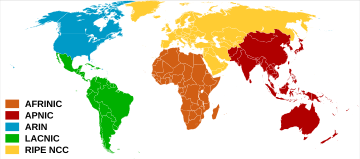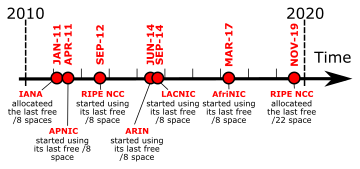IPv4 address exhaustion facts for kids
Imagine the internet as a huge city, and every device (like your phone or computer) needs a unique address to find its way around. These addresses are called IPv4 addresses. IPv4 address exhaustion means we're running out of these unique addresses.
When the internet was first designed, people thought about 4.3 billion addresses would be plenty. But the internet grew super fast, much more than anyone expected! So, experts realized way back in the 1980s that we might run out. Running out of IPv4 addresses is why a newer system, called IPv6, was created. IPv6 has a lot more addresses! Right now, both IPv4 and IPv6 work together on the internet.
The job of giving out these addresses is handled by a group called the Internet Assigned Numbers Authority (IANA). They work with five big organizations called Regional Internet Registries (RIRs). These RIRs give addresses to internet companies (like your ISP) and big businesses in different parts of the world. The main reasons IPv4 addresses ran out faster were: more and more people using the internet, devices that are always connected, and lots of mobile phones.
Because this shortage was expected, new technologies were created. These include network address translation (NAT) and Classless Inter-Domain Routing (CIDR) in 1993. IPv6 was also developed in 1998.
The very top level of addresses ran out on January 31, 2011. After that, the RIRs also started running out of their main pools of addresses. This happened on April 15, 2011, for Asia-Pacific (APNIC), June 10, 2014, for Latin America and the Caribbean (LACNIC), September 24, 2015, for North America (ARIN), April 21, 2017, for Africa (AfriNIC), and November 25, 2019, for Europe, Middle East, and Central Asia (RIPE NCC). These RIRs still give out some addresses that are returned or saved for special uses. Also, individual internet companies might still have some unused addresses they can give out.
One of the internet's creators, Vint Cerf, admitted he thought 4.3 billion addresses would be enough because he saw the internet as just an experiment at first.
Contents
What is an IP Address?
Every device connected to an Internet Protocol (IP) network needs an IP address. This includes computers, routers, or network printers. An IP address helps locate and identify the device so it can communicate with others.
IPv4 uses 32-bit addresses, which means it can have 2 to the power of 32 different addresses. That's about 4.3 billion unique addresses. However, some large groups of IPv4 addresses are saved for special uses and cannot be given out to the public.
The number of public IPv4 addresses is not enough to give a unique address to every single internet device or service. This problem has been helped for a while by changing how addresses are given out and how internet traffic is routed. For example, moving from an older system to Classless Inter-Domain Routing (CIDR) helped delay the shortage. Also, network address translation (NAT) allows many devices in a private network to share just one public IPv4 address. This means an internet company doesn't need to give a public address to every single device.
Why Addresses Ran Out
While the main reason for IPv4 addresses running out is that the original internet design didn't have enough space, several other things made the problem worse. Each of these increased the demand for the limited supply of addresses, often in ways no one expected when the internet was first built.
- Mobile devices: As IPv4 became the main way digital devices communicated, and as the cost of powerful small devices dropped, mobile phones became able to connect to the internet. Newer 4G phones actually need IPv6 addresses.
- Always-on connections: In the 1990s, most people connected to the internet using dial-up modems. These connections were usually temporary. But by 2007, broadband internet was very common. Broadband connections are always on because the routers and modems are rarely turned off. This meant that internet companies needed to keep more addresses assigned, speeding up the exhaustion.
- More internet users: In 1990, very few homes had internet. Just 15 years later, almost half had fast, always-on connections. Many new internet users in countries like China and India also greatly increased the demand for addresses.
- Inefficient address use: Some organizations that got IP addresses in the 1980s were given far more addresses than they actually needed. This happened because the old way of giving out addresses was not very efficient. For example, large companies or universities were given huge blocks of addresses (over 16 million each) because the next smaller block (65,536 addresses) was too small for them. Many organizations still use public IP addresses for devices that are only used within their local network, which isn't always the most efficient use of global addresses.
What Was Done to Help
Efforts to slow down the exhaustion of addresses began when the problem was first noticed in the early 1990s. Several temporary solutions were introduced to make the existing system work better, such as CIDR methods and strict rules for giving out addresses based on actual use.
The Internet Engineering Task Force (IETF) created a special group in 1991 to deal with the problem of the internet's growth.
IPv6, the newer version of IPv4, was designed to solve this problem. It supports a massive number of network addresses (about 340 undecillion!). Even though the IPv4 addresses were running out quickly by 2008, most internet companies and software makers were just starting to use IPv6.
Other efforts and technologies to help include:
- Using network address translation (NAT), which lets a private network use just one public IP address.
- Using private network addresses, which are not visible on the public internet.
- Allowing multiple websites to share one IP address using name-based virtual hosting.
- Stricter control by the regional Internet registries on how addresses are given out.
- Reorganizing networks and using subnetting to get back large blocks of addresses that were given out inefficiently in the early days of the internet.
When Addresses Ran Out
On January 31, 2011, the last two main blocks of unreserved addresses from IANA were given out to APNIC. This left five blocks that were reserved but not yet given out. According to the rules, IANA then gave one of these five blocks to each of the five RIRs at a special event on February 3, 2011. This officially exhausted the main IANA pool.
APNIC was the first regional Internet registry to run out of its freely available IPv4 addresses on April 15, 2011. This meant that not everyone who needed a new IPv4 address could get one easily. Because of this, some applications that need a direct connection between devices across the internet might not work perfectly until IPv6 is fully used everywhere. However, IPv6 devices cannot directly talk to IPv4 devices. They need special services to communicate. This means that regular computers still need IPv4 access, often through methods like NAT64, in addition to their new IPv6 address.
In early 2011, only about 16-26% of computers could use IPv6, and very few preferred it. Only about 0.15% of the top million websites could be reached using IPv6. To make things more complicated, some people couldn't reach websites that used both IPv4 and IPv6.
Technologies to help with IPv4 exhaustion include:
- Sharing IPv4 addresses to access IPv4 content.
- Using both IPv4 and IPv6 at the same time (called dual-stack).
- Translating between IPv4 and IPv6 to access content.
- Using tunnels to bypass single-protocol routers.
After IANA ran out of addresses, more people started adopting IPv6.
Regional Exhaustion Dates
All the RIRs have saved a small group of IP addresses specifically for the changeover to IPv6. When only this last small group remains, the RIR's supply of IPv4 addresses is considered "exhausted."
- APNIC (Asia-Pacific) was the first RIR to limit how many addresses it gave out, on April 14, 2011. This region includes fast-growing internet markets like China and India.
- RIPE NCC (Europe, Middle East, Central Asia) was the second RIR to run out of its main address pool on September 14, 2012.
- LACNIC (Latin America and the Caribbean) was the third RIR to run out on June 10, 2014.
- ARIN (North America) ran out on September 24, 2015. They had already been unable to give out large requests since July 2015.
- AFRINIC (Africa) became the last RIR to reach its final block of IPv4 addresses on March 31, 2017. On January 13, 2020, they entered their second phase of exhaustion.
- On November 25, 2019, RIPE NCC announced they had made their "final" IPv4 allocation. They will now only give out IPv4 addresses that are returned by organizations that no longer need them. They also strongly encouraged everyone to switch to IPv6.
Impact of APNIC Exhaustion
Because APNIC ran out of addresses, systems that need to connect across continents already have to deal with the address shortage.
At APNIC, before the main pool ran out, existing members could apply for a 12-month supply of addresses if they were using more than 80% of their current allocation. Since April 15, 2011, when APNIC reached its last main block, each member (new or old) can only get one allocation of 1024 addresses. APNIC expects this last block to last for many years because of this policy.
The 1,024 addresses can be used by APNIC members to provide services like NAT44 or NAT64 on an IPv6 network. However, for a new, large internet company, 1,024 IPv4 addresses might not be enough to connect all their customers due to the limited number of ports available per IPv4 address.
APNIC and ARIN (North America) have a policy that allows IPv4 addresses to be transferred between their regions. This policy was put in place for ARIN on July 31, 2012. Businesses have even started up to help with these transfers of IPv4 addresses.
Important Warnings About Exhaustion
Estimates for when IPv4 addresses would completely run out changed a lot in the early 2000s. In 2003, an APNIC director thought it would last one or two more decades. By September 2005, a report suggested it could be as little as 4 to 5 years. In the last year before exhaustion, addresses were being given out even faster, making the predicted exhaustion dates come sooner.
- On May 21, 2007, ARIN (North America) warned that because exhaustion was expected by 2010, moving to IPv6 was necessary for any applications needing continuous IP addresses.
- On June 20, 2007, LACNIC (Latin America and the Caribbean) advised preparing networks for IPv6 by January 1, 2011, as IPv4 addresses were expected to run out in three years.
- On June 26, 2007, APNIC (Asia-Pacific) supported a statement that moving to an IPv6-based internet was needed for continued growth, due to expected exhaustion around 2010.
- On October 26, 2007, RIPE NCC (Europe, Middle East, Central Asia) urged that widespread use of IPv6 should be a high priority for everyone.
- On April 15, 2009, ARIN sent letters to companies, saying they expected IPv4 space to be gone within two years.
- In May 2009, RIPE NCC launched IPv6ActNow.org to help explain IPv6 and encourage its global adoption.
- On August 25, 2009, ARIN announced events to promote IPv6 in the Caribbean, reporting less than 10.9% of IPv4 addresses remained.
- World IPv6 Day on June 8, 2011, was a test where many websites temporarily enabled IPv6 to see how it worked.
- World IPv6 Launch Day on June 6, 2012, was a bigger event where many organizations permanently enabled IPv6 on their networks.
- On September 24, 2015, ARIN officially declared its IPv4 address pool exhausted.
- On November 25, 2019, RIPE NCC announced its "final" IPv4 allocation.
- On August 21, 2020, LACNIC announced its final IPv4 allocation.
What Happens After Exhaustion
By 2008, planning for what would happen after IPv4 addresses ran out was already underway. Several ideas were discussed to delay the shortage:
Getting Back Unused IPv4 Space
In the past, when addresses were given out in a less efficient way, some organizations received very large blocks of IP addresses. Now, IANA could potentially take back these unused addresses and give them out in smaller blocks. ARIN, RIPE NCC, and APNIC have policies that allow addresses to be returned and then reassigned. However, it can be costly and time-consuming for a large network to change its addresses, so organizations might not want to give them up. Even if all these unused addresses were reclaimed, it would only delay the exhaustion for a short time.
Also, some IP address blocks were given to organizations that no longer exist, or parts of blocks were never used. It's hard to track down exactly which addresses are truly unused, as many are used only within private networks.
Some address space previously saved by IANA has been added to the available pool. There have been ideas to use the "Class E" range of IPv4 addresses (which would add about 268.4 million IP addresses). However, many computer and router systems don't allow these addresses to be used. So, instead of making them public, proposals suggest allowing them for private networks that need more addresses than currently available.
Several organizations have returned large blocks of IP addresses. For example, Stanford University gave back a huge block of 16 million IP addresses in 2000. Other organizations, like the United States Department of Defense, have also returned addresses.
Buying and Selling IP Addresses
Creating a market to buy and sell IPv4 addresses has been considered a way to deal with the shortage and redistribute addresses. The main benefit of such a market is that it allows buyers to keep their networks working without interruption. While IPv6 is being adopted, it's still early days. It requires a lot of investment and can have compatibility issues with IPv4, as well as some security and stability risks.
- A market for IPv4 addresses would only delay the problem for a relatively short time, as the internet is still growing.
- The idea of legally owning IP addresses as property is generally not supported by ARIN and RIPE NCC policies.
- Random trading of addresses could lead to messy routing patterns, which might make the global routing table too large and cause problems for routers.
- Microsoft bought 666,624 IPv4 addresses from Nortel for $7.5 million. Before exhaustion, Microsoft could have gotten addresses from ARIN for free if they could show they needed them. This purchase gave Microsoft enough addresses for their growth for the next 12 months, which was more than the usual 3-month supply.
How to Transition to IPv6
As the IPv4 address pool runs out, some internet companies won't be able to give public IPv4 addresses to all their customers. However, customers will still need to access services on the IPv4 internet. Several technologies have been developed to provide IPv4 service even when using an IPv6 network.
- ISP-level IPv4 NAT: Internet companies might use network address translation (NAT) within their own networks and give private IPv4 addresses to customers. This could let customers keep using their existing equipment.
- NAT64: This translates IPv6 requests from devices to IPv4 requests. This means devices don't need IPv4 addresses, and IPv6-only devices can access IPv4 websites. However, it needs a special DNS server and doesn't work for IPv4-only devices.
- DS-Lite (Dual-Stack Lite): This uses tunnels from the customer's home router to a network address translator at the internet company. The home router puts IPv4 packets inside an IPv6 "wrapper" and sends them to a special device. This device then unwraps the packets and performs NAT before sending them to the public internet. This allows different customers to use the same private IPv4 addresses, avoiding the need to give private IPv4 addresses to each customer.
- Address plus Port: This allows public IP addresses to be shared based on port numbers. Each device gets an IPv4 address and a range of port numbers to use. Other devices can share the same IPv4 address but use a different range of ports.
The Long-Term Solution: IPv6
Using IPv6 is the official, long-term solution to the IPv4 address shortage. IPv6 is supported and used by all internet technical groups and network equipment makers. It has many improvements, including replacing the 32-bit IPv4 address with a 128-bit address. This provides an address space that is practically unlimited for the future. IPv6 has been actively used since June 2006. To help devices using only IPv4 talk to IPv6 devices, various IPv6 transition mechanisms are used.
See also
 In Spanish: Agotamiento de las direcciones IPv4 para niños
In Spanish: Agotamiento de las direcciones IPv4 para niños
- List of assigned /8 IPv4 address blocks
- 512K Day – an event in 2014, involving the exhaustion of the default allocation of hardware routing slots on many routers







